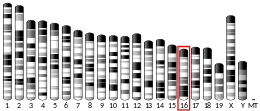ALG1
Chitobiosyldiphosphodolichol beta-mannosyltransferase is an enzyme that is encoded by ALG1[5] whose structure and function has been conserved from lower to higher organisms.[6][7]
Function
The biosynthesis of lipid-linked oligosaccharides is highly conserved among eukaryotes and is catalyzed by 14 glycosyltransferases in an ordered stepwise manner. The Alg1 mannosyltransferase I (MT I) catalyzes the first mannosylation step in this process.[6] Clinically, the deficiency of ALG1 in humans results in ALG1-CDG, a congenital disorder of glycosylation.[8]
References
- GRCh38: Ensembl release 89: ENSG00000033011 - Ensembl, May 2017
- GRCm38: Ensembl release 89: ENSMUSG00000039427 - Ensembl, May 2017
- "Human PubMed Reference:". National Center for Biotechnology Information, U.S. National Library of Medicine.
- "Mouse PubMed Reference:". National Center for Biotechnology Information, U.S. National Library of Medicine.
- Couto JR, Huffaker TC, Robbins PW (1984). "Cloning and expression in Escherichia coli of a yeast mannosyltransferase from the asparagine-linked glycosylation pathway". J. Biol. Chem. 259 (1): 378–82. PMID 6368538.
- "Entrez Gene: ALG1 asparagine-linked glycosylation 1 homolog (S. cerevisiae, beta-1,4-mannosyltransferase)".
- Takahashi T, Honda R, Nishikawa Y (Mar 2000). "Cloning of the human cDNA which can complement the defect of the yeast mannosyltransferase I-deficient mutant alg 1". Glycobiology. 10 (3): 321–7. doi:10.1093/glycob/10.3.321. PMID 10704531.
- "# 608540 CONGENITAL DISORDER OF GLYCOSYLATION, TYPE Ik; CDG1K". Johns Hopkins University. Retrieved 2019-05-01.
Further reading
- Couto JR, Huffaker TC, Robbins PW (January 1984). "Cloning and expression in Escherichia coli of a yeast mannosyltransferase from the asparagine-linked glycosylation pathway". J. Biol. Chem. 259 (1): 378–82. PMID 6368538.
- Gao XD, Nishikawa A, Dean N (June 2004). "Physical interactions between the Alg1, Alg2, and Alg11 mannosyltransferases of the endoplasmic reticulum". Glycobiology. 14 (6): 559–70. doi:10.1093/glycob/cwh072. PMID 15044395.
- Otsuki T, Ota T, Nishikawa T, et al. (2007). "Signal sequence and keyword trap in silico for selection of full-length human cDNAs encoding secretion or membrane proteins from oligo-capped cDNA libraries". DNA Res. 12 (2): 117–26. doi:10.1093/dnares/12.2.117. PMID 16303743.
- Gerhard DS, Wagner L, Feingold EA, et al. (2004). "The Status, Quality, and Expansion of the NIH Full-Length cDNA Project: The Mammalian Gene Collection (MGC)". Genome Res. 14 (10B): 2121–7. doi:10.1101/gr.2596504. PMC 528928. PMID 15489334.
- Kranz C, Denecke J, Lehle L, et al. (2004). "Congenital Disorder of Glycosylation Type Ik (CDG-Ik): A Defect of Mannosyltransferase I". Am. J. Hum. Genet. 74 (3): 545–51. doi:10.1086/382493. PMC 1182267. PMID 14973782.
- Schwarz M, Thiel C, Lübbehusen J, et al. (2004). "Deficiency of GDP-Man:GlcNAc2-PP-Dolichol Mannosyltransferase Causes Congenital Disorder of Glycosylation Type Ik". Am. J. Hum. Genet. 74 (3): 472–81. doi:10.1086/382492. PMC 1182261. PMID 14973778.
- Grubenmann CE, Frank CG, Hülsmeier AJ, et al. (2004). "Deficiency of the first mannosylation step in the N-glycosylation pathway causes congenital disorder of glycosylation type Ik". Hum. Mol. Genet. 13 (5): 535–42. doi:10.1093/hmg/ddh050. PMID 14709599.
- Clark HF, Gurney AL, Abaya E, et al. (2003). "The Secreted Protein Discovery Initiative (SPDI), a Large-Scale Effort to Identify Novel Human Secreted and Transmembrane Proteins: A Bioinformatics Assessment". Genome Res. 13 (10): 2265–70. doi:10.1101/gr.1293003. PMC 403697. PMID 12975309.
- Strausberg RL, Feingold EA, Grouse LH, et al. (2003). "Generation and initial analysis of more than 15,000 full-length human and mouse cDNA sequences". Proc. Natl. Acad. Sci. U.S.A. 99 (26): 16899–903. doi:10.1073/pnas.242603899. PMC 139241. PMID 12477932.
External links
- GeneReviews/NCBI/NIH/UW entry on Congenital Disorders of Glycosylation Overview
- Human ALG1 genome location and ALG1 gene details page in the UCSC Genome Browser.
This article is issued from Wikipedia. The text is licensed under Creative Commons - Attribution - Sharealike. Additional terms may apply for the media files.



